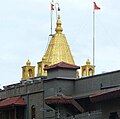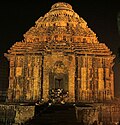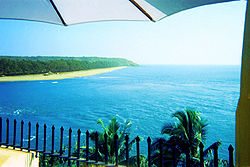Top Qs
Timeline
Chat
Perspective
Tourism in India
From Wikipedia, the free encyclopedia
Remove ads
Tourism in India is 4.6% of the country's gross domestic product (GDP). Unlike other sectors, tourism is not a priority sector for the Government of India. The World Travel and Tourism Council calculated that tourism generated ₹13.2 lakh crore (US$160 billion) or 5.8% of India's GDP and supported 32.1 million jobs in 2021. Even though, these numbers were lower than the pre-pandemic figures; the country's economy witnessed a significant growth in 2021 after the massive downturn during 2020. The sector is predicted to grow at an annual rate of 7.8% to ₹33.8 lakh crore (US$400 billion) by 2031 (7.2% of GDP).[1] India has established itself as the 5th largest global travel healthcare destination with an estimated market size of around $9 billion in 2019, out of the total global travel healthcare industry of $44.8 billion(2019).[2][3] In 2014, 184,298 foreign patients travelled to India to seek medical treatment.[4]
This article needs to be updated. The reason given is: Update on COVID-19 and tourism industry. (July 2021) |
According to the Ministry of Tourism, over 6.19 million and 1.52 million foreign tourists arrived in India in 2022 and 2021 respectively compared to 10.93 million in 2019, representing a -44% degrowth.[5][6] In 2022, Gujarat Tops India in Foreign Tourism with 20.17% Share in 2022. Gujarat rose as a global tourism hotspot continues with over 15.40 lakh tourists visiting in 2023.[7] In 2023, 2509.63 million Domestic Tourist Visits (DTVs) were recorded (provisionally) compared to 1731.01 Million DTVs in 2022.[8]
The World Economic Forum's Travel and Tourism Development Index 2021, which replaced its previous Travel and Tourism Competitiveness Report, ranks India 54th out of 117 countries overall.[9] The last edition of the Travel and Tourism Competitiveness Report, published in 2019, had ranked India 34th out of 140 countries overall. The report ranked the price competitiveness of India's tourism sector 13th out of 140 countries. It mentioned that India has quite good air transport infrastructure (ranked 33rd), particularly given the country's stage of development, and reasonable ground and port infrastructure (ranked 28th). The country also scored high on natural resources (ranked 14th), and cultural resources and business travel (ranked 8th).[10] The World Tourism Organization reported that India's receipts from tourism during 2012 ranked 16th in the world, and 7th among Asian and Pacific countries.[11]
The Ministry of Tourism designs national policies for the development and promotion of tourism. In the process, the Ministry consults and collaborates with other stakeholders in the sector including various central ministries/agencies, state governments, union territories and private sector representatives. Concerted efforts are being made to promote niche tourism products such as rural, cruise, medical and eco-tourism.[12] The Ministry of Tourism maintains the Incredible India campaign focused on promoting tourism in India.
Remove ads
Visa policy of India
Summarize
Perspective
India requires citizens of most countries to hold a valid passport and apply for a travel visa at their local Indian embassy or consulate before their visit. Travellers can apply directly by mail or in person, or through their local travel services company. In 2014, India implemented an online method for citizens of 156 countries to apply for an e-Tourist Visa.[13][14]
Nationals of Bhutan, Maldives, and Nepal do not require a travel visa to enter India. Citizens of Afghanistan, Argentina, Bangladesh, DPR Korea, Jamaica, Maldives, Mauritius, Mongolia, Nepal, South Africa and Uruguay are not required to pay a fee when obtaining an Indian visa.[15][16]
During the pandemic year 2020, India had access to just 23 countries for travel, whereas now the Indian passport holders can travel visa-free to 60 countries.[17]
A Protected Area Permit (PAP) is required to enter the states of Nagaland and Sikkim and some parts of the states of Arunachal Pradesh, Himachal Pradesh, Jammu and Kashmir, Manipur, Mizoram, Rajasthan and Uttarakhand. A Restricted Area Permit (RAP) is required to enter the Andaman and Nicobar Islands and parts of Sikkim. Special permits are needed to visit the Lakshadweep islands.[18]
e-Tourist Visa
As a measure to boost tourism,[19] the Indian Government implemented a new visa policy in November 2014, allowing tourists and business visitors to obtain a "visa on arrival" at 28 international airports, by acquiring an Electronic Travel Authorisation (ETA) online before arrival, without having to visit an Indian consulate or visa centre.[20] In April 2015, the "visa on arrival" scheme was renamed "e-Tourist Visa" (or "e-TV") to avoid confusion.[21]
The e-Tourist Visa facility requires a tourist to apply online on a secure Government of India website, at least four to thirty days before the date of travel. If approved, the visitor must print and carry the approved visa with their travel documents. The visa allows holders of an ETA to enter and stay anywhere in India for a period of ninety days except for citizens of US, UK, Japan and Canada. Citizens of these countries can stay for up to 180 days at a time. an ETA can be obtained twice in a single calendar year.[13]
India first introduced its "visa on arrival" facility on 27 November 2014, to citizens of the following countries: Australia, Brazil, Cambodia, Cook Islands, Djibouti, Fiji, Finland, Germany, Indonesia, Israel, Japan, Jordan, Kenya, Kiribati, Laos, Luxembourg, Marshall Islands, Mauritius, Mexico, Micronesia, Myanmar, Nauru, New Zealand, Niue, Norway, Oman, Palau, Palestine, Papua New Guinea, Philippines, Russia, Samoa, Singapore, Solomon Islands, South Korea, Thailand, Tonga, Tuvalu, UAE, Ukraine, USA, Vanuatu and Vietnam.[13] On 30 July 2015, the facility was extended to China, Macau and Hong Kong.[22] On 15 August 2015, the facility was further extended to citizens of Andorra, Argentina, Armenia, Aruba, Belgium, Bolivia, Colombia, Cuba, East Timor, Guatemala, Hungary, Ireland, Jamaica, Malta, Malaysia, Mongolia, Monaco, Mozambique, the Netherlands, Panama, Peru, Poland, Portugal, Seychelles, Slovenia, Spain, Sri Lanka, Saint Lucia, Saint Vincent and the Grenadines, Suriname, Sweden, Taiwan, Tanzania, Turks and Caicos Islands, the United Kingdom, Uruguay and Venezuela.[23] The facility should eventually be expanded to about 180 countries. As a result of the new visa policy, 56,477 tourists arrived on an e-Tourist Visa during October 2015, compared with 2,705 tourist arrivals during October 2014 (just before the facility was introduced), representing a 1987.9% increase. During the period from January to October 2015, a total of 258,182 tourists arrived on an e-Tourist Visa, a 1073.8% increase on the 21,995 tourist arrivals during the same period in 2014 (before the e-Tourist Visa was available).[24]
Remove ads
Statistics
Summarize
Perspective
Domestic tourists
During 2021, the number of Domestic Tourist Visits to the States/UTs was 67,76,32,981(677 million approx.) as compared to 61,02,16,157(610 million approx.) in 2020 registering a growth of 11.05%.[25]
Foreign tourist arrivals and foreign exchange earnings

Foreign and domestic tourist visits by State
Remove ads
World Heritage Sites
There are 42 World Heritage Sites in India that are recognised by the United Nations Educational, Scientific and Cultural Organization (UNESCO) as of August 2023.[30][31]
Responsible tourism in India
Elephant camps
Riding elephants is a popular tourist activity in India. While the total number of elephants used for tourism in India is relatively low compared to other Asian countries (350 in India in 2017 compared to almost 2,200 in Thailand[32]), tourists will still have opportunities to ride elephants at historic sites and watch captive elephants perform in sports and shows[33] and religious rituals.[34]
In early 2019, several prominent responsible tourism businesses including Responsible Travel and Intrepid Travel stopped selling tours including elephant rides citing reasons of animal cruelty and abuse. Later in 2019, The Association of British Travel Agents (ABTA) updated its animal welfare guidelines, labelling elephant riding as unacceptable.[35]
Remove ads
Gallery
- North India
- Chambal River gorge in Kota
- New Tehri in Uttarakhand popular for floating resorts
- Bhangarh Fort, a very popular fort city in Alwar
- Umaid Bhawan Palace in Jodhpur
- Boats on Naini Lake in Nainital city
- Lotus Temple in Delhi
- Tso Moriri in Ladakh
- Pahalgam in Kashmir
- Gulmarg in Kashmir
- Sonmarg in Kashmir
- Indira Gandhi Memorial Tulip Garden in Kashmir
- Nubra Valley in Ladakh
- Puga Valley in Ladakh
- Chhatarpur Temple in South Delhi
- South India
- Gandikota river valley in Andhra Pradesh
- Mallalli Falls in Kodagu during Monsoon season
- Honnavar is famous for the most beautiful backwaters
- Lambasingi hill station
- Stone chariot in Hampi
- Grasslands in Kudremukh National Park during Monsoon
- Mysore Palace illuminated at night
- Idukki Dam in Kerala
- Natural bridge in Neil Island
- Beach on Havelock Island
- Coral reef in Jolly Buoy Island, Andaman
- Central India
- Chitrakote Falls, the largest waterfalls in India at Jagdalpur
- Omkareshwar Temple in Mandhata
- Gwalior Fort, oldest fort in India
- Mahakal Lok corridor in Ujjain
- Boating club in Bhopal, The City of Lakes
- Bhimbetka rock shelters, a UNESCO World Heritage Site located near Bhopal
- West India
- Kadiya Dhro in Rann of Kutch, Gujarat
- Palolem Beach in Goa
- Kaas Plateau, part of a UNESCO World Natural Heritage Site
- Forts of Maharashtra are also called Green canyon of India
- Lonar Lake, a notified National Geo-heritage Monument
- Sai Baba temple in Shirdi
- Aguada Fort, Goa
- An Asiatic Lion family in Gir National Park
- Ajanta Caves in Maharashtra
- View of Western Ghats in Lonavala
- East India
- NorthEast India
Remove ads
Outline of tourism in India
Summarize
Perspective
Tourist attractions
Tourism in states
List of tourism in different states of India
- Tourism in Andaman and Nicobar
- Tourism in Andhra Pradesh
- Tourism in Arunachal Pradesh
- Tourism in Assam
- Tourism in Bihar
- Tourism in Chandigarh
- Tourism in Chhattisgarh
- Tourism in Dadra and Nagar Haveli and Daman and Diu
- Tourism in Delhi
- Tourism in Goa
- Tourism in Gujarat
- Tourism in Haryana
- Tourism in Himachal Pradesh
- Tourism in Jammu and Kashmir
- Tourism in Jharkhand
- Tourism in Karnataka
- Tourism in Kerala
- Tourism in Ladakh
- Tourism in Lakshadweep
- Tourism in Madhya Pradesh
- Tourism in Maharashtra
- Tourism in Manipur
- Tourism in Meghalaya
- Tourism in Mizoram
- Tourism in Nagaland
- Tourism in Odisha
- Tourism in Puducherry
- Tourism in Punjab
- Tourism in Rajasthan
- Tourism in Sikkim
- Tourism in Tamil Nadu
- Tourism in Telangana
- Tourism in Tripura
- Tourism in Uttar Pradesh
- Tourism in Uttarakhand
- Tourism in West Bengal
- Tourism in North East India
- Shikkaras at Dal lake, Jammu and Kashmir, India
- Khajuraho Temple, Madhya Pradesh, India
- Beach of Goa, India
- Gangotri Glacier, Uttarakhand, India
- A Tea Garden of Cachar, Assam, India
- Kaziranga National Park, Assam, India
- Kumbh Mela Sangam, Allahabad, Uttar Pradesh, India
- Akshardham Temple, Delhi, India
- India Gate, New Delhi
- Taj Mahal, Agra, Uttar Pradesh, India
- Ladakh is a popular mountaineering site for climbers and trekkers.
- The White Rann of Kutch, Gujarat
- Thar Desert, Rajasthan
Remove ads
See also
References
Further reading
External links
Wikiwand - on
Seamless Wikipedia browsing. On steroids.
Remove ads








































































































